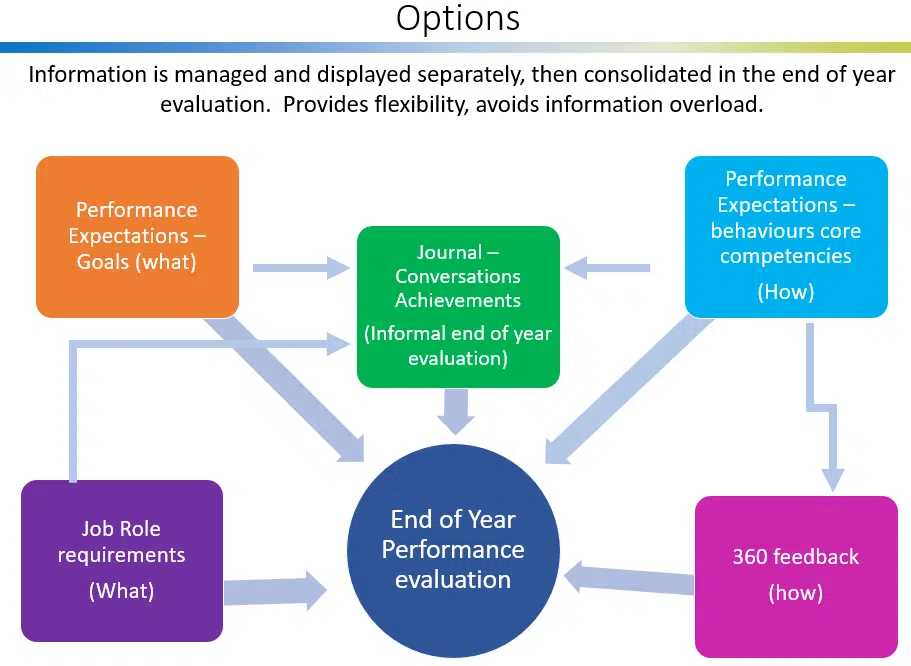Performance Management
Software
Continuous, compliant, and connected — from goals to development.
Performance Management Software should do more than record annual reviews — it should drive continuous improvement, development, and accountability. Centranum’s Performance Management software combines job role OKRs, goals, competencies, and feedback in a single platform. Managers and employees gain clarity on expectations, progress, and results, while HR teams get consistent, auditable data across the organization. With configurable workflows, integrated development planning, and real-time reporting, Centranum helps organizations strengthen individual contribution and align performance with business outcomes.
Empower your people with transparent expectations, goal alignment, meaningful feedback and fair evaluation — all in one configurable continuous performance management software system.
Trusted by government, healthcare, engineering and tech organizations for fair, effective performance management systems.
Why Performance Management Matters
Effective performance management isn’t just about individual reviews — it’s about creating organizational clarity and accountability. When expectations are clear and feedback is consistent, employees are more engaged, managers can lead with confidence, and leadership gains real visibility into workforce capability.
Without a structured performance management process, organizations risk misaligned goals, subjective evaluations, and disengaged staff. With the right system, performance management becomes a driver of culture, ensuring fairness, transparency, and alignment between daily work and long-term strategy.
For enterprises, this means stronger employee retention, better succession pipelines, and data-driven insight into where to invest in development. For employees, it means clarity of expectations, recognition of achievements, and a transparent view of career growth opportunities.
Avoid the Pitfalls of Outdated Performance Management Software
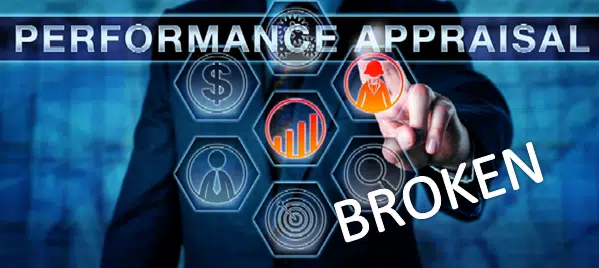
- Performance reviews seen as a box-ticking exercise, wasting time & resources
- Expectations aren’t aligned with organizational objectives.
- Feedback is infrequent and poor quality
- Opportunities for talent development are missed
Centranum helps you replace outdated performance reviews with a continuous performance management process based on role clarity, fairness and real development.
Drive employee engagement and accountability with performance management software designed to promote regular feedback and reduce administration
Centranum Performance Management Platform Architecture
Performance Management Software Components
Centranum’s enterprise grade performance management architecture integrates six core components:
- Job Roles – define responsibilities and expectations clearly for every employee.
- Competencies & Values – link performance to the knowledge, skills, and behaviours that matter.
- Goals – set and align SMART goals or OKRs across individuals, teams, and the organization.
- Journal – capture feedback and performance conversations in real time, with a full audit trail.
- Reviews – structured appraisals with ratings, narratives, and calibration for fairness.
- Development Plans – turn gaps into actionable objectives, tied to learning resources and career growth.
Together, these components make performance management continuous, evidence-based, and aligned with organizational strategy.
Performance Management Solution - choose your Starting Points
Start with what fits your context:
Your Values based behavior or core competency expectations PLUS
-
Option 1: Goals-First Approach
Set and track goals aligned with values, KPIs, and development needs. -
Option 2: Role-Based Performance
Assess and develop performance based on clear role expectations
or use both options in combination.
Expand your approach with:
- Employee Development Planning for skill and capability gaps
- Smart reviews with configurable settings for periods, display and processes
- Evaluation Calibration options for consistency
- Journals for capturing achievements and feedback
- 360 Feedback
📌 Everything stays connected — no duplication, no silos.
Performance Management In Action
Performance Management Process
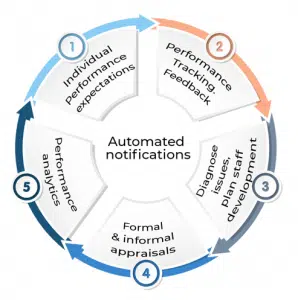
Clear Expectations
- What – Role Responsibilities, Specific Objectives
- How – Values Based Behaviours
Regular Tracking & Feedback
Performance Diagnostics – identify & address issues
Formal or Informal Performance Reviews/Appraisals
Real Time Reports & Analytics
Staff Dashboard
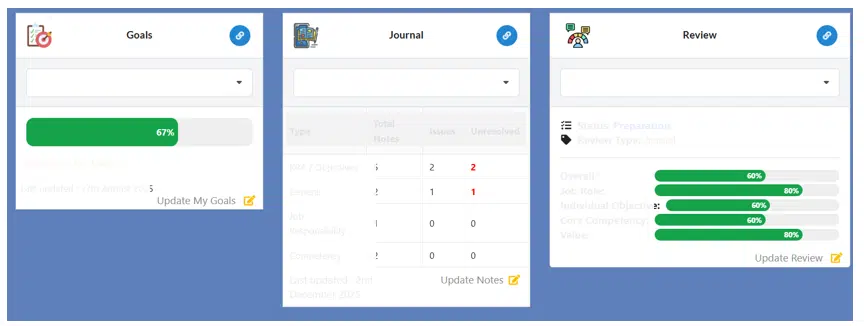
Manager Dashboard
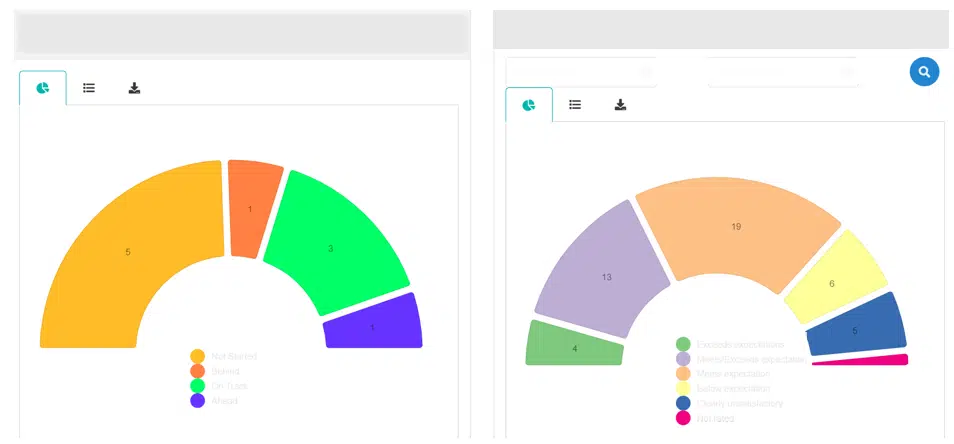
Why choose Centranum?
It’s different
Credible Performance Management
- Flexible and configurable to meet any content, process, display and reporting needs
- Aligns performance with role responsibilities, capability and development — not just KPIs
- Promotes real-time feedback and progress tracking, not once-a-year reviews
- Includes evidence-based performance diagnostics
- Optional 360 feedback with sentiment and theme analysis

Secure platform with role based access and enterprise grade controls
Proven success across industries
With an international client base spanning 20 years, our approach has demonstrated consistent improvements in performance management processes across knowledge-based industries.
Who it’s helps
For staff

- Understand expectations with clear responsibilities (OKRs) and goals, review career pathways
- Record achievements and performance conversations as input for end of year reviews
- Create & track development plans, find the right learning resources
- Access it all in one personal dashboard
For Managers & Team Leaders

- Set and align team goals with organizational priorities
- Track and record real time performance conversations
- Hold career conversations and identify next step opportunities
- Conduct structured, fair reviews with minimal admin
- Identify skill gaps, create development plans and track progress
- Access team performance overviews and analytics
For Senior Leaders & Executives

- Align individual contributions with values and organizational goals
- Support a culture of accountability and continuous growth
- Gain strategic oversight into performance, capability, and development across the organization
- Access readiness and talent pool insights for planning and governance
For HR, OD, L&D Teams

- Configure performance management settings, processes, steps to fit organizational needs
- Configure rating and scoring models to provide calibration support
- Streamline performance reviews and reduce administrative burden
- Access overviews of formal review process completion, rating distributions and drill down to view anomalies
- Use interactive reports to mass update waivers, moderation and rollover steps
- Embed performance and competency data into development and succession processes
- Use insights to target training and measure impact
FAQs
What is continuous performance management?
Continuous performance management is the ongoing process of setting goals, tracking progress, capturing feedback, and reviewing performance throughout the year — rather than relying on a once-a-year appraisal.
How does performance management software support development planning?
Performance reviews and journals link directly to individual development plans. Gaps identified in reviews automatically feed into objectives, which can be tied to learning resources or training initiatives.
Can Centranum’s performance management system support compliance audits?
Yes. Every review, goal, and feedback entry is time-stamped and version-controlled, creating a transparent, auditable record of performance processes.
Is 360 feedback included in Centranum’s performance management solution?
Centranum integrates with its dedicated 360 Feedback module. This allows organizations to include multi-rater feedback in performance discussions when needed, alongside manager and self-assessments.
How does an employee performance management system help a business?
Effective performance management tools align employee activity with organizational goals. They help managers clearly define expectations, track progress, and identify strengths and gaps in real time. Techniques such as structured reviews, continuous feedback, and capability-based evaluation provide actionable insights that drive accountability, development, and results — not just compliance.
Our platform connects these tools with role definitions and capabilities, ensuring performance is measured against what really matters.
What are best practices for implementing effective performance management?
- Start with role clarity. Expectations must be grounded in real responsibilities.
- Make goals visible. Connect them to team and organizational priorities.
- Use competency-based feedback. Evaluate what people do and how they do it.
- Enable continuous feedback. Journals and informal check-ins improve accuracy and timeliness.
- Link performance to development. Turn insights into development action plans.
- Automate the routine. Let the system handle deadlines, reminders, and workflows.
Our platform supports all of the above in a modular, scalable way — whether you’re just starting or optimizing an existing process.
Can we start with just goal setting and reviews?
Yes. You can begin with goals and periodic reviews, or go deeper with job expectations and competency-based evaluation. Our platform supports both paths.
Is this system suitable for remote and hybrid teams?
Absolutely. Our platform provides a unified view for staff and managers, no matter where work happens — supporting continuous performance dialogue.
How does Centranum ensure frequent feedback on performance expectations
Frequent feedback requires more than manager intention — it needs smart systems that prompt action. Our platform enables ongoing conversations with built-in feedback journals and development plans, automated nudges, and progress indicators that make performance expectations and development objectives visible. Review cycles are proactive, not reactive.
Our system also lets you tailor frequency and format to your organization’s culture — supporting both structured reviews and informal check-ins.
What are the pros and cons of using 360-degree feedback in performance reviews?
Pros
- Offers a well-rounded view of employee performance, beyond the manager’s perspective
- Helps surface blind spots in behavior and interpersonal skills
- Encourages a culture of accountability and continuous improvement
Cons:
- Can backfire without clear process guardrails or psychological safety
- Feedback may be biased or vague without well structured prompts
- Time-consuming if not automated
Our 360 Feedback module is designed to mitigate these issues — with configurable relationships, process settings that reduce risk of harm, and AI-driven analysis for actionable themes and sentiment.
How do you ensure fairness in evaluations?
By anchoring reviews to defined roles, responsibilities, and competencies — and using multiple data points including feedback, development actions, and outcomes. Ensuring that rating scales are not just short labels but have expanded descriptions and using calibration to ensure consistency of ratings for each individual rater as well as between raters.
How can automation help the performance management process
Automation removes manual administration steps so managers can focus on guidance & coaching, and HR on talent development, not chasing performance management tasks.
Our platform automates:
- Setting up reviews when people start, change roles and at each new period
- Displaying the correct expectations to the right manager
- Guiding users with role-specific prompts and workflow
- Notifying contributors of next actions at the right time
This ensures compliance without micromanagement — and saves significant admin time.
How do performance management software integrations enhance overall HR functionality?
Integrations allow performance data to flow seamlessly across systems — improving decision-making and reducing duplication.
For example:
- Pull user and role data from HRIS for real-time org context
- Link learning records from LMS for development tracking
- Sync review data with compensation tools or BI dashboards
Our platform is designed for integration, with structured APIs and alignment across role, performance, development, and talent planning.
What are the pros and cons of using Generative AI in performance management?
Pros:
- Can generate summaries of feedback or reviews, saving time
- Assists in surfacing themes across large datasets (e.g. 360 reports)
- Supports coaching with prompts based on capability gaps and identification of suitable learning resources
Cons:
- Risk of inaccuracies or misinterpretations
- Needs human validation, especially for sensitive topics
- Requires governance to prevent misuse
We use AI as a co-pilot — not a replacement. AI assists in summarizing feedback and identifying sentiment themes, but we always leave the judgment to managers and employees.

